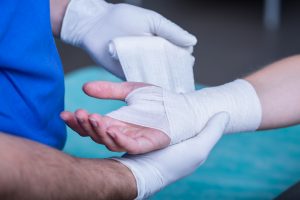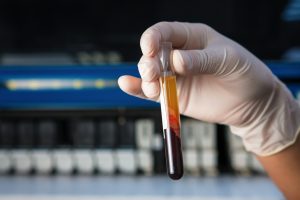
Burn Rehabilitation: Not Just Skin Deep
Treatment GuidelinesWhen patients leave the burn center, they need continued care. If a clinician does not have experience with burns, they might not recognize what is happening beneath the surface in time to prevent contractures.
Can you tell when a burn injury still needs rehabilitation, even if the skin color has returned to normal? Clinicians without burn rehabilitation experience might miss the signs. They can easily be lulled into believing all is well when the burn scar starts to disappear. But continuing care at this stage is crucial to making a full recovery.
Linda Ware, OTR, CHT, Coordinator of Burn Rehabilitation at Johns Hopkins Bayview Medical Center has treated more than her fair share of burn patients. The Johns Hopkins Burn Center offers a comprehensive, nationally recognized program of care for patients with burn injuries from Maryland, the surrounding states, and even from many other countries.
Working at the burn center, her team of physical and occupational therapists are experienced in burn management. They know to advise patients to continue proper stretching even though the surface of the skin appears normal.
Taking a Deeper Look into Burn Rehabilitation
Beneath the surface, a burn injury takes longer to heal internally. Some patients regain full range of motion after the initial acute stage of healing. But the full healing process is not complete at this point.
After the initial stage of healing, the scar tissue may begin to contract. Contraction pulls and can damage even the unaffected skin surrounding the burn. If left untreated, this contraction could seriously affect range of motion. It is crucial to continue proper stretching to prevent any impairment of mobility.
The scar tissue is the most active three to four months after the injury occurs. The skin on the surface may appear normal as the scar color and redness disappears. But this color change period does not mark the end of rehabilitation.
Continued Care for Burn Rehabilitation
When inpatients leave the burn center after acute rehabilitation, they need continued care. Some patients can’t find a clinic in their hometown with burn management specialists. If a clinician does not have experience with burns, they might not recognize what is happening beneath the surface in time to prevent contractures.
In these special cases, the John Hopkins Burn Center takes the extra step to ensure their patients make a full recovery. Burn specialists will often provide extensive plan of care advice and informal phone consultations to those therapists taking over the burn patient’s care.
This ensures that the patient receives proper continued care for their burn injury, and helps educate clinicians who may not have had previous experience with burn care.
Keys to Success: Clinician Teamwork and Patient Independence
Other features that distinguish the Johns Hopkins Burn Center are the staff teamwork and its ability to empower patients. Linda proudly reports that PTs and OTs work together seamlessly to cover both inpatient and outpatient burn rehabilitation. Having a cohesive staff promotes positive outcomes for the work environment and the patient experience.
At the burn center, patients get a sense of ownership and independence using the BTE Simulator II. Many patients change the attachments and progress through their pre-programmed series of exercises using the computer screen on their own. They like the independent activity and feeling of accomplishment, Linda says.
Nearly every patient at the burn center utilizes the Simulator II. It facilitates motions that safely stretch the skin over multiple joints. Click here to see how to code reimbursement for diagnosis and treatment with the Simulator II.
Serious Burns
For a burn to be classified as ‘serious,’ it usually has damaged the skin beyond the top layer. The damage may even penetrate the muscle and sometimes the bone. The average inpatient stay for serious burn patients is 11 days. Serious burns can be further classified into the following degrees that most people are familiar with.
Second-Degree Burns
Some (but not all) second-degree burns fall into the serious category. These usually cause painful blisters that can pop, and require constant care to keep clean and prevent injury.
These injuries generally result in very short hospital stays, if at all. Rehab for these cases is usually not extensive. While most second-degree burns heal within two to three weeks without significant scaring, some may require skin grafts. Second-degree burns could also require therapy visits when the burned area affects movement of a joint.
Third-Degree Burns
Third-, fourth- and fifth-degree burns are the most serious, and need the specialty care of a complete burn center and inpatient care. Third-degree burns, or full thickness burns, destroy the outer layer of skin (epidermis) and the entire layer beneath (dermis). Large area third-degree burns heal slowly and poorly without proper medical attention.
Fourth- and Fifth-Degree Burns
Severe burn inpatient stays can be extensive if new skin will not grow. Severe burn rehabilitation begins with inpatient care as soon as the patient can tolerate movement of the affected area. Fourth- and fifth-degree burns affect muscle tissue and even the bone, and involve the longest hospital stays and the most extensive rehab.
After hospital discharge for any of these burns, outpatient rehab then continues at the Hopkins Burn Center with visits scheduled three to five days per week, and can last six months to a full year. Patients often need reconstructive surgery, which leads to more rehab visits.
Surgeries for Burn Rehabilitation
Insurers usually view each surgery as a new incident. For example, skin grafts might call for surgeries, followed by deeper surgery on muscle and connective tissue.
As surgeries progress, most insurers allow more rehabilitation visits. They understand the need for continued burn rehabilitation to prevent further injury and surgeries.
How OSHA has Changed Burn Injuries
According to Linda, most serious burns occur in the home. In the past, the most likely cause was industrial or workplace accidents. But thanks to the Occupational Safety and Health Administration’s regulations, the risk of a workplace burn has decreased. Recent workplace safety regulations have greatly improved workplace safety, especially for burn accidents.
On the other hand, that makes your home the most likely place for a burn accident. The burn center has seen numerous burns resulting from bon fires, camp fires and grills, especially with alcohol consumption. Other less frequent causes of severe burns can be boat accidents and people with oxygen tanks using cigarette lighters – one more reason to quit smoking.
Road to Recovery
The road to recovery after a serious burn injury is a long one. Burn specialists in both physical therapy and occupational therapy begin the process with acute care, and must continue through the total rehabilitation process.
The Johns Hopkins Burn Center provides world-class care to its patients. Both physical therapists and occupational therapists work seamlessly together to engage and empower patients, and ensure continued care after discharge.
For more information on burn rehab, contact the Johns Hopkins Burn Center.
John Vermette
Director of Provider and Product Management
BTE





